Osteochondrosis is a widespread disease of the intervertebral discs that occur in people of different age groups.Today it is diagnosed in more than 40% of young people under the age of 35, and among the older category affects 9 out of 10 people.There are several stages of development, and the earlier the pathology is detected, the easier and more effective the treatment and the lower the risk of developing dangerous complications.
What is osteochondrosis
The intervertebral discs are located between the vertebral bodies and are a type of shock absorbers that absorb stress when walking or performing other physical activities.They have different sizes depending on their position: in the cervical region the discs are the smallest, and in the lumbar spine they are the largest.
All are built the same.In the center is the pulposus core, which is the main ingredient of the disk and has high elasticity.It is surrounded by a fibrous membrane and bullets.
Osteochondrosis is a degenerative-district disease in which there is a change in the shape and size of the intervertebral discs as a result of their erosion and the prerequisites are created for the formation of hernia, deformation of vertebral bodies, spondylosis and other disorders.
Disk entry is a consequence of cartilage malnutrition, which leads to a gradual decrease in its elasticity and increased fragility.
As a result, the discs change the position, their height decreases, and the micrococks form on their fibrous membrane.This creates serious prerequisites for the formation of intervertebral hernias, pinching of spinal roots or blood vessels.
The smallest changes in the disks condition lead to the breakdown of their functions.This is associated with pain of varying degrees of intensity.At the same time, prerequisites are created for the development of diseases of the internal organs, as the quality of their activity depends directly on the condition of the spine and the conductivity of bioelectric impulses along the nerves.
It can affect one or more intervertebral discs in any part of the spine.Therefore, osteochondrosis is diagnosed:
- cervical spine;
- thoracic spine;
- lumbar spine.
In particularly severe cases, the pathological process involves most of the intervertebral discs of the spinal column, which is associated with discomfort throughout the back and an almost complete loss of performance.But more often, osteochondrosis affects the lumbar spine, as it holds the largest load, as well as the intervertebral discs of the cervical backpack due to their high mobility.
and developmental
During osteochondrosis, 4 stages can be distinguished approximately:
- A decrease in the level of disk hydration, which leads to its dehydration and the formation of micrococks.Often at this stage there are still no manifestations of the initial disease.
- A decrease in the height of the disk, which leads to the appearance of the first symptoms of pathology.At this stage, there is a decrease in the distance between individual segments, which leads to a decrease in spinal ligament tone and creates the possibility of moving vertebrae from their natural positions, ie, the development of spondylolysis.In such situations, a course of illness is most often observed.It can distinguish between periods of irritation, accompanied by acute pain and periods of forgiveness, in which there is no embarrassment at all or has painful pain.
- Deformation of the affected intervertebral disk with the formation of extension or prolapse.Sometimes there is inclusion of joints in the pathological process, which is manifested by the development of arthrosis or vertebral subluxations.At this stage, the immune system responds to the processes that occur in the spine by developing aseptic inflammation with swelling of the tissue surrounding the affected spinal-motor segment.In this case, the pain occurs regularly, the reflex muscle spasms, as well as the restrictions on mobility, can be observed.In rare cases, signs of neurological deficit (radical syndrome) already develop as a result of the pinch of nerve fibers from the resulting extensions of the intervertebral discs.
- Developing complications.Since the human body has extensive compensatory abilities, when the intervertebral disc loses its ability to perform its functions, the process of osteosynthesis is activated to provide vertebrae in a stable position.This leads to the formation of bone protrusions - osteophytes - at the ends of the vertebral bodies of the affected segment of the spinal movement.As a result, because of them, two or more beads join tightly together, forming a single conglomerate, ie.Spondylosis develops.This always leads to rounded nerves and the development of acute neurological symptoms in the form of paresis, paralysis and serious concerns in the functioning of the respective internal organs.
Reason
There are many theories today for the development of osteochondrosis, including vascular, mechanical, hereditary, hormonal, infectious-allergic and others.But none of them are able to fully explain the mechanism of developing changes in the tissue of the intervertebral disc.Therefore, most likely, they all complement each other.
Thus, a large number of very diverse factors can lead to the development of osteochondrosis.Among them, the most important are:
- genetic predisposition;
- regular performance of heavy physical labor;
- keeping a sedentary lifestyle;
- the presence of scoliosis or other spinal deformities;
- suffering from back damage;
- unbalanced diet, vitamin deficiency;
- Infectious diseases;
- metabolic disorders;
- congenital spine abnormalities (kimerli abnormalities, chiari abnormal, craniovertebral abnormality, sacralization, lumbarization);
- overweight;
- Regular heavy stress.
It is believed that the most important impact on the condition of the intervertebral discs is the constant overload of a certain segment of the spinal movement.This can be not only doing strong monotonous physical work, but also constant stooping or long -term landing habit.In such situations, extra stress is placed on discs, muscles and ligaments, and other factors only exacerbate the situation.
In general, osteochondrosis can be called an almost natural age -related disease, which is an inevitable price to pay to walk straight.
Symptoms
The earliest sign of the development of the disease is the appearance of a oppressive sound in the spine part where the onset of degenerative-district changes is observed.It is a consequence of the occurrence of disk feeding and the advancement of its dehydration.At this stage, patients almost never seek medical help.Therefore, their daily routine, eating habits and other factors remain the same, which contributes to the deterioration of the situation and the passage of the disease in the second phase.
As a result, the typical symptoms of osteochondrosis begin to appear:
- severe muscle tension in the affected area in only one or both sides of the spine;
- sharp and painful pain that intensifies with every movement and gain intensity over time, becoming unbearable;
- numbness in the arms or legs;
- weakness;
- the stiffness of the movements, the unauthorized restriction of mobility;
- Lowering muscle tone until atrophy;
- poor behavior;
- increase in blood pressure.
As the pathology progresses, signs of osteochondrosis deteriorate.80% of patients suffer dull pain in the area of the affected spinal cord segment, which is also characteristic of myositis.
Osteochondrosis of the cervical spine
When affecting the cervical pillar, the pain tends to radiate to the shoulder band, arms and other manifestations of neurological disorders.Patients keep their heads in the least painful position, and if necessary, they return with their whole body.
Moreover, the pathologies of the organs that are internal from the spinal cervical spine region can develop:
- tinnitus and diseases of ENT organs;
- dizziness;
- unclear vision;
- migraines;
- Irritability and anxiety levels increase;
- sleep problems;
- increased risk of allergic reactions;
- Reduce thyroid hormone levels.
With cervical spine osteochondrosis, vertebral artery syndrome and vegetative-vascular dystonia are often diagnosed.
Cervical spine infection with osteochondrosis, especially when complicated by intervertebral prolongs and hernias, can lead to pinch of blood vessels.This is fraught with damaged blood supply to the brain, which can be associated with dizziness attacks, loss of consciousness and even a stroke.
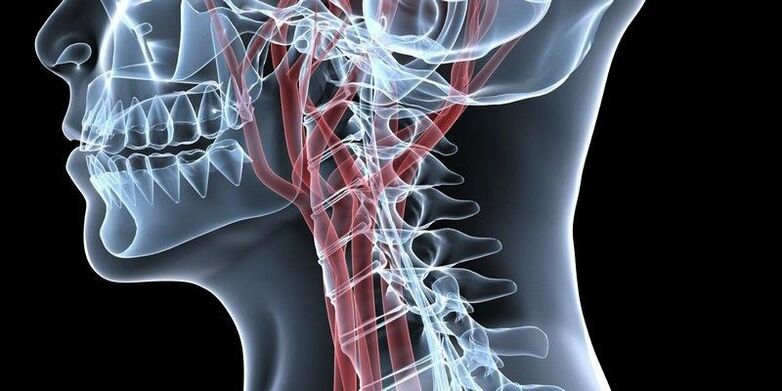
Osteochondrosis of the spine
With osteochondrosis of the thoracic region, which is rarely diagnosed, the pain appears in the spine at the shoulder blade level and can intensify even when taking a deep breath.They often feel behind the chest, which can be mistaken for heart disease.
When the roots of the spine grow, the risk of diseases of the internal organs increases, in particular:
- bronchi and lungs (asthma, bronchitis, pneumonia, pleurisy);
- gall bladder and its canal, liver (cholecystitis, jaundice, fat absorption disorders);
- pancreas and duodenum (digestive disorders, pain in left hypochondrium);
- adrenal glands, which affect the overall strength of the immune system and can provoke the development of allergies;
- kidneys (urinary disorders, chronic pyelonephritis, glomerulonephritis, etc.);
- Pelvic organs (digestive disorders, gynecological diseases, urological, infertility).
Fact: Damage to the intervertebral disc of the 7th thoracic vertebra from osteochondrosis can lead to the development of diabetes mellitus.
Lumbosacral back osteochondrosis
With the osteochondrosis of the Lumbar region, Lumbago, called Lumbago, is observed.This is associated with burnt, unbearable pain that occurs suddenly.Often, patients even find it difficult to sit, rise and walk, which can indicate the development of radicular syndrome.In such situations, it is easy to notice how they slowly sit and stand up, trying as much as possible to avoid the slope of their torso.
If complications occur, the main risk is pinch the nerves of cauda equina, as this can lead to damaged control over the processes of intestinal and bladder emptying, as well as paralysis of the legs.Also in such cases it can be developed:
- appendicitis;
- diarrhea, constipation;
- pain in the lower abdomen;
- bladder dysfunction;
- powerless;
- knee pain, legs, buttocks or groin area;
- Swelling of the legs.
Complications
Osteochondrosis is a possible cause of a large number of different diseases.Most often, if left untreated, it leads to the formation of extension and intervertebral hernia.This in turn can cause:
- Discogy myelopathy, which ends in paresis, muscle atrophy, changes in tendon reflexes, loss of control over urination and defecation, and even limb paralysis;
- radiculopathy;
- other scoliotic or spinal deformity;
- spinal cord infarction due to the compression of the artery that feeds it;
- stroke due to the compression of the occipital artery.
Troubleshooting
The appearance of pain in the back and neck should be a reason to contact a neurologist or vertebologist.The sooner the osteochondrosis is diagnosed, the easier and more effective the treatment will be.
To diagnose the disease, the doctor interviews and examines the patient.Based on their results, it is already possible to assume the presence of degenerative changes in the intervertebral discs.But for a final diagnosis, instrumental diagnostic methods have been described, including:
- MRI;
- Ct;
- X-ray in two projections.
The magnetic resonance imaging provides the most complete information about the condition of the intervertebral disc.The procedure is mainly performed on closed -type devices with a power of 1.5 T. With its help, you can distinguish osteochondrosis from tuberculosis spondylitis, osteomyelitis, infectious diseases, etc.
CT scans and X -rays provide information about the bone structures of the spine.Thanks to them, it is possible to detect the displacement of vertebral bodies, the presence of osteophytes and other disorders.
Moreover, it can be determined below:
- Ultrasound with dopplerography of the neck vessels;
- Electromography;
- Laboratory research.
The treatment of osteochondrosis
Therapy develops individually for each patient.In this case, the severity of degenerative-destrophic processes, the presence of complications, the nature of the patient's work activity and a number of other factors must be taken into account.
All patients should be prescribed a set of measures, as it is impossible to eliminate pathological changes in the intervertebral discs only with the help of medicines.Conservative therapy components for osteochondrosis may include:
- medication therapy;
- osteopathy;
- manual therapy;
- Physiotherapy (phonophoresis, ozone therapy, carboxytherapy, pressure, RF currents);
- Individual sessions with a rehabilitation.
All patients diagnosed with intervertebral disk dystrophy are advised to reconsider their lifestyle.It is necessary to set aside time for moderate physical activity, especially for representatives of sitting occupations, or, conversely, to think about changing occupations for people who are forced to set up heavy objects daily.
But in the acute period, full rest is recommended.It is provided not only by maintaining the rest of the bed, but also by wearing orthopedic bandages: in the event of cervical back damage, a shants collar is used;In case of osteochondrosis of the lumbar region, it is recommended to wear a corset.
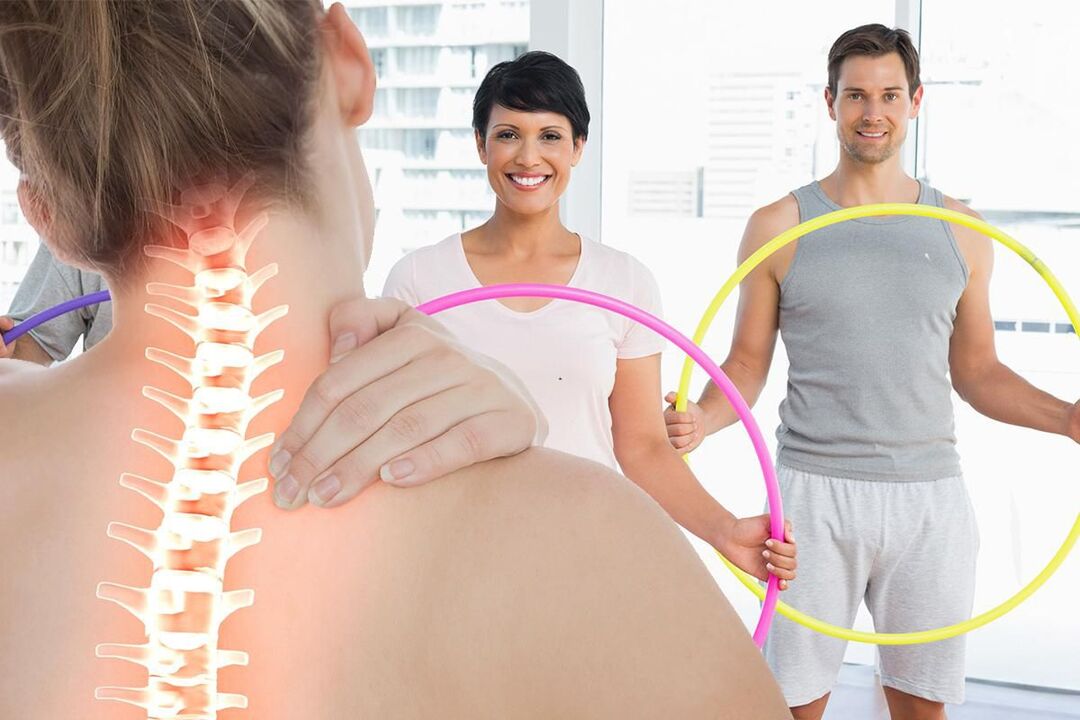
In the early stages of developing the disease, it is often enough to make your lifestyle adjustments, engage in exercise therapy and visit a chiropractor.In more advanced cases, medication therapy and physiotherapy are necessarily prescribed.
Never address self-medication with suspicious means, self-recession of anti-inflammatory drugs, as well as suspicious "healing" that are positioned online: you can lose not only time, money, but also remains of your health.
Drug therapy
For osteochondrosis, a complex of medicines is prescribed to reduce pain, eliminate inflammation and muscle spasms reflex, improve nerve transmission, and activate the processes of intervertebral disk tissue.
Therefore, patients are prescribed:
- NSAIDs-help reduce pain and have an anti-inflammatory effect;
- Corticosteroids-represents powerful anti-inflammatory properties;
- Muscle relaxants - eliminate muscle spasms, which helps reduce back pain;
- B vitamins - ensure improved functioning of the nervous system in general and tracking nerve impulses along individual nerves in particular;
- Vitamin D is a remedy responsible for the condition of bone tissue, as well as higher brain functions, such as memory, attention, speech;
- Chondroprotectors - feed the intervertebral discs with the compounds needed for the construction of new nuclear pulposus fibers;
- Psychotropic drugs-Relieves the effectiveness of non-steroidal anti-inflammatory drugs and muscle relaxants;
- Vascular medicines - improve blood circulation in the tissues surrounding the spine, which provides a more active supply of nutrients and oxygen to the intervertebral discs;
- Anticonvulsants - used in rare cases to ease very severe spasms.
For very severe pain, which most often shows complications, patients can suffer rear blockades, which provide an immediate effect.Sometimes corticosteroid hormones add to the solution to perform the blockade.This also leads to a pronounced anti-inflammatory effect.
Blocks are carried out in conditions of absolute infertility, which can only be achieved in specialized medical institutions.At the same time, they require special knowledge and skills, so only a highly qualified health worker can competently handle the task.Otherwise, there is a high risk of infection or damage to the nerve fiber, which will lead to the development of severe complications.
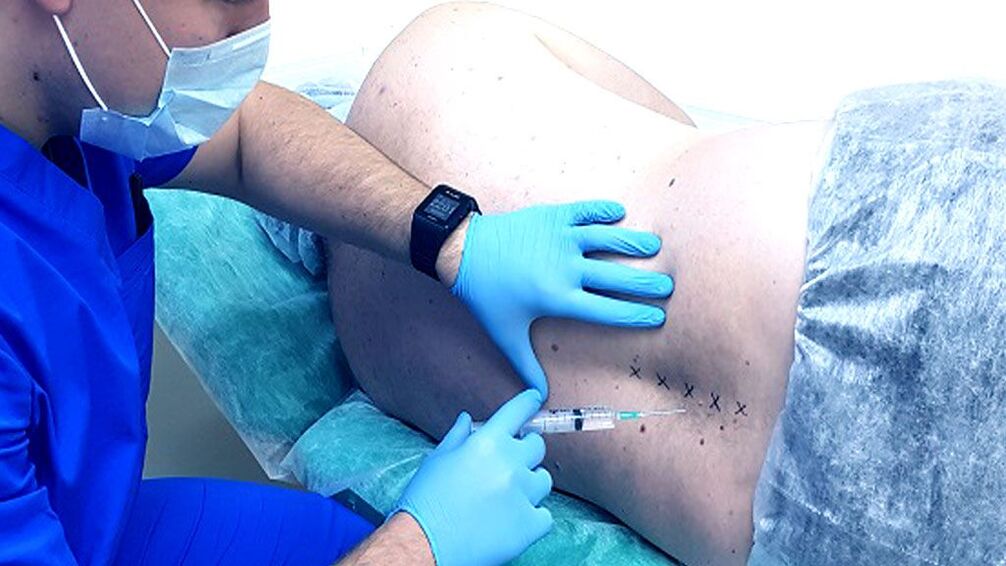
During the blockade, injections are usually given on both sides of the spine in the area where the nerves that cause pain cause.There are several techniques for performing them, among which the specific one is selected by the doctor individually.
But it is advisable to perform blockages no more than 4 times a year.Since with osteochondrosis, acute and painful pain attacks appear much more often, it is worthwhile to eliminate the causes of their occurrence, ie.Degenerative-district process in the Union itself.
Manual therapy
Manual therapy sessions are described outside the period of deterioration of osteochondrosis.They play one of the key roles in the treatment of the disease, as the competent use of manual techniques in the back and the surrounding tissue helps not only to stop the progression of the pathological process in the intervertebral discs, but also to create the most favorable conditions for their restoration.
Moreover, certain techniques can also have a positive effect on the functioning of the internal organs.For example, one of the methods is designed, normalizing the position of each beads, to eliminate pressure on the spinal roots, blood vessels and spinal membranes and thereby restore the normal bonding of the organ to the nervous system.This makes it possible to eliminate the hidden causes of the development of the above diseases of the heart, bronchitis, lungs, kidneys, gastrointestinal tract and reproductive system and leads to complete recovery.
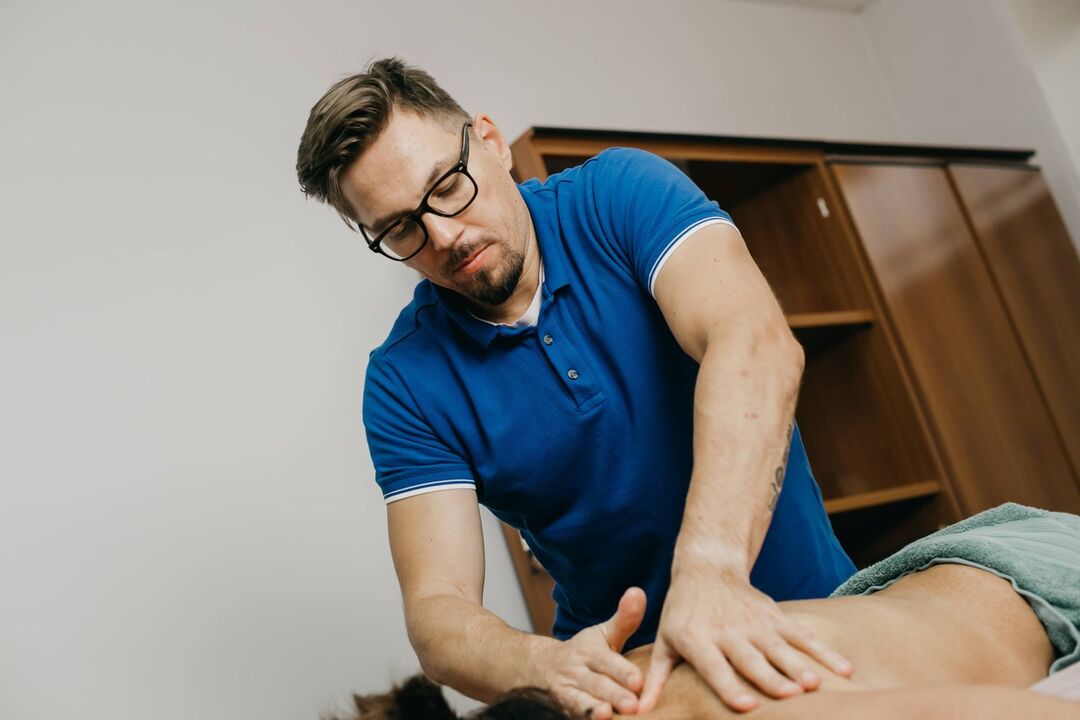
Thanks to the effect of jewelry precision on the back, not only does blood circulation activate and metabolism accelerates, both with a classic therapeutic massage, but also natural self-healing mechanisms are launched.The elimination of spinal curves, incorrect position of vertebrae and other pathological changes in the spine through manual therapy can further strengthen the immune system, improve overall well -being, and significantly improve the quality of life.
Positive changes can be observed after the first session, and in the future their severity increases alone.
Physiotherapy
Physiotherapeutic procedures increase the effectiveness of all other methods of treatment of osteochondrosis and help reduce pain.Most often used:
- Electrophoresis - the use of electric current to ensure penetration of anesthetics, anti -inflamator and other agents directly at the site of inflammation, allowing you to quickly get a pronounced therapeutic effect;
- Ultrasound therapy - the effect of ultrasound provides an analgesic effect, increases the intensity of metabolic processes in the field of impact, and creates prerequisites for high quality diluted intervertebral discs;
- Intra Therapy - involves extension and massage of the spine on a special striped mattress, which activates blood circulation and increases muscle tone;
- Attractive therapy or spinal withdrawal - is performed using special devices that create an attractive load on the back, as a result of which the distance between the vertebrae and the pressure on the coated intervertebral disk is increased, which allows it to be more actively cured.
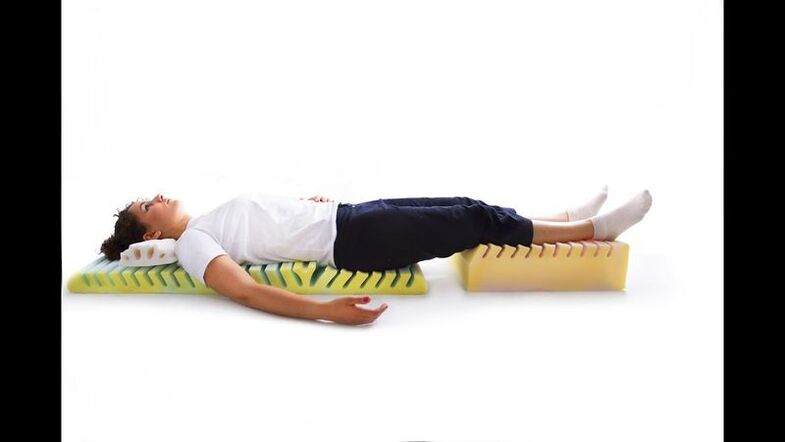
All procedures are described in courses of 10-15 sessions.When choosing them, they consider not only the condition of the intervertebral discs but also the presence of concomitant diseases, as some of them have certain physical effects are contraindicated.
Exercise therapy
Therapeutic exercises for osteochondrosis play an important role, as the exercises precisely selected for damage to different parts of the spine can help form a strong muscle corset and at the same time eliminate increased muscle tone.This will provide good support for the spine and stop the progress of the degenerative process on the intervertebral discs.Moreover, exercise therapy helps activate blood circulation and increase the intensity of metabolic processes.
Drafting a physical therapy program is the task of a rehabilitation physician.Based on the severity of the spinal lesion, the characteristics of the patient's physical development, his age and other factors, he will create an optimal set of exercises, the implementation of which will create an optimal load on the muscles and spine.
The first classes should be done under the supervision of a doctor.After the patient learns to perform each exercise correctly, he is allowed to continue to practice at home.It is important to avoid any sudden movement.All exercises are performed daily slowly and smoothly, and the load gradually increases.But the appearance of pain during training is a good reason to refuse to perform the exercise that provoked it.

PREVENTION
It is much easier to prevent the development of a disease than to deal with its consequences later.Since osteochondrosis can occur all sooner or later, you should think about the potential risks as soon as possible and make any effort to prevent this.Therefore, each person should adhere to the following recommendations:
- Avoid physical inactivity, exercise regularly, swim, and while sitting, take regular breaks to heat;
- Pay attention to your attitude when walking or sitting;
- buy a high quality orthopedic mattress and pillow;
- Observe the correct technique for lifting weights: with a straight back and bent knees;
- Change casual shoes to more comfortable ones and leave dress shoes for special occasions;
- Eat well so that the body does not suffer nutritional deficiencies and weight remain within normal limits.
There is only one way to avoid the appearance and appearance of osteochondrosis symptoms - start taking care of yourself and your health.Since osteochondrosis is not only a disease, but a complex of muscle-tonic and neurodizstrophic changes, which are the body's response to physical inactivity, chronic static spinal muscle tension, environmental situations and chronic neurosis, especially common among city dwellers, swimming in the pool and programs including yoga.
Thus, osteochondrosis is a very common disease, but with careful attention to your health, you can fight it effectively at any age.But ignoring the problem will not lead to anything good and sooner or later will force the patient to lie on the table of operation.
























